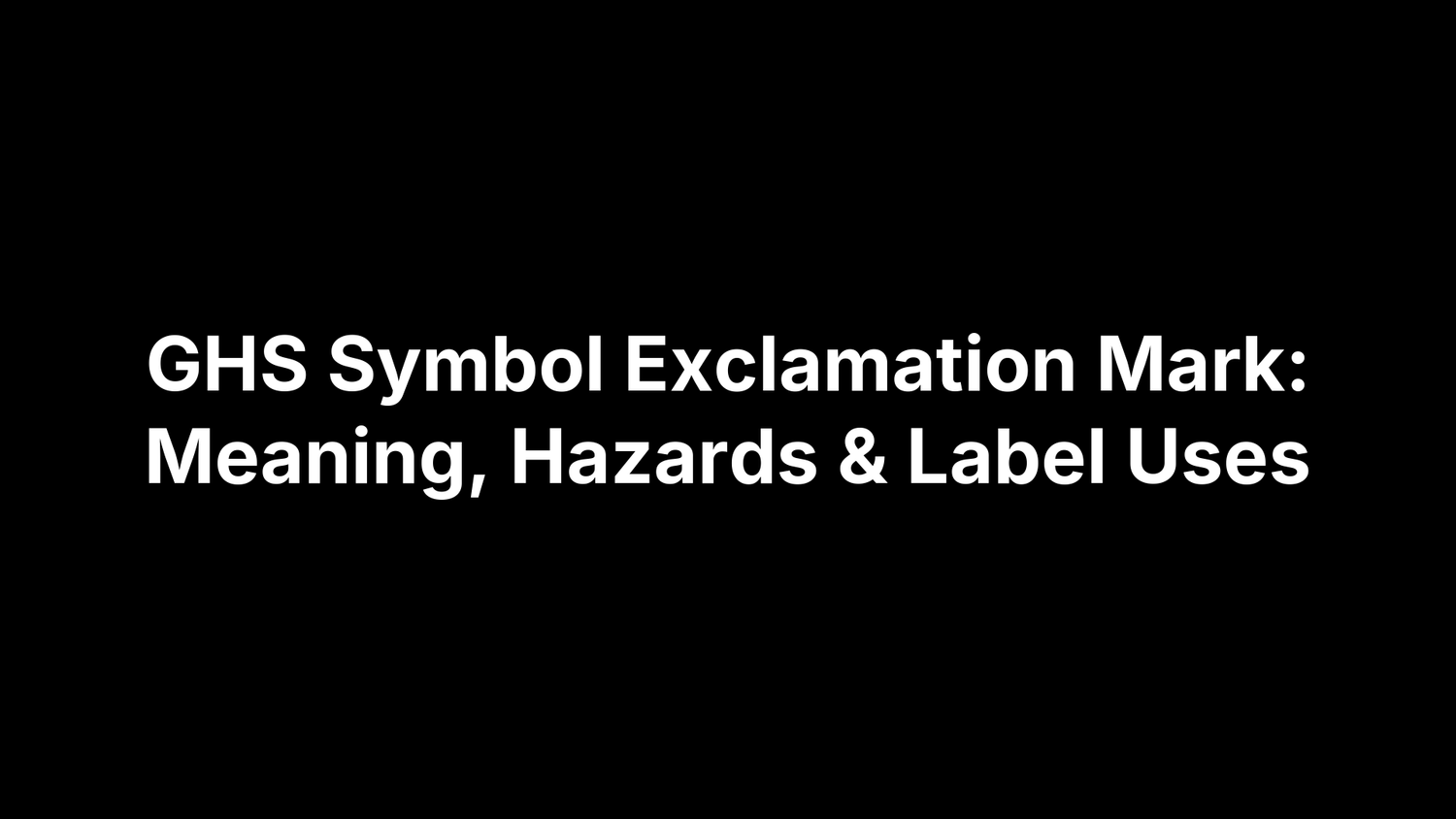GHS Symbol Exclamation Mark: Meaning, Hazards & Label Uses
A red-bordered diamond with a bold black exclamation mark is shorthand for “handle with caution.” Officially labeled GHS07, this pictogram flags lower-tier yet still serious hazards: skin or eye irritation, respiratory irritation, acute toxicity Category 4, skin sensitization, narcotic effects such as dizziness, and chemicals that damage the ozone layer. When you see it, the product demands protective gear, clear instructions, and OSHA/WHMIS-compliant labeling.
Because the Globally Harmonized System assigns nine different symbols—and some hazards overlap—the exclamation mark is also one of the most frequently misapplied. The guide that follows breaks down the official definitions, category thresholds, label placement rules, and everyday handling tips so you can classify chemicals with confidence, avoid costly citations, and keep workers safe.
You’ll also find practical design advice for durable GHS decals and quick-reference FAQs ready to share at your next safety meeting.
1. What the Exclamation Mark Pictogram Represents
Before you can place the symbol on a label—or decide to leave it off—you need to know exactly what regulators mean by it, what it must look like, and which hazard categories trigger it.
1.1 Official GHS Definition (GHS07)
The United Nations GHS calls this pictogram “a black exclamation mark on a white background framed by a red diamond.” Under OSHA’s Hazard Communication Standard (29 CFR 1910.1200) and Canada’s WHMIS 2015, the graphic, size rules, and cutoff values are identical. Its shorthand code is GHS07.
1.2 Visual Anatomy of the Symbol
- Red square set on a point (diamond) for instant recognition
- Minimum 2 mm red line weight; white interior must remain clean
- Centered black “!” drawn without stylized fonts
These color and shape cues let workers spot the hazard from several feet away—even on a crowded shelf.
1.3 Hazard Classes Assigned to GHS07
- Acute toxicity Cat 4 (oral, dermal, inhalation)
- Skin irritation Cat 2
- Eye irritation Cat 2/2A
- Skin sensitizer Cat 1
- STOT-SE Cat 3 (respiratory irritation or narcotic effects)
- Hazardous to ozone layer (optional for OSHA)
A product showing more severe categories carries additional pictograms instead of, or alongside, the exclamation mark.
2. Hazards and Health Effects in Plain Language
Seeing the exclamation mark means “this might hurt, but probably won’t kill you—if you respect it.” The effects are acute, show up quickly, and are usually reversible when exposure stops. Below is a no-jargon cheat-sheet you can share with crew members who don’t speak regulator-ese yet.
2.1 Irritation vs. Corrosion: How Serious Is “Irritant”?
Irritants sting, redden, or swell skin and eyes, but the tissue heals once the material is washed away. Think diluted acid cleaner splashed on your arm—unpleasant but fixable. Corrosives, flagged by the “test-tube eating a hand” pictogram, burn straight through layers of skin and never fully heal. Knowing which is which prevents under- or over-protecting staff.
2.2 Acute Toxicity Category 4 Explained
Category 4 sits in a middle LD₅₀ window—300 mg/kg < oral LD₅₀ ≤ 2 000 mg/kg. It won’t earn the skull-and-crossbones, yet a mouthful could still require ER care. Isopropyl alcohol is the classic example: safe on wipes, dangerous when chugged.
2.3 Respiratory and Narcotic Effects
Many solvents—toluene, xylene, acetone—can irritate airways or make you woozy after a few deep breaths. These narcotic effects fade in fresh air, but dizziness at height or around machinery invites accidents.
2.4 Skin Sensitization & Allergic Reactions
A sensitizer trains your immune system to misfire. After repeated contact with epoxy resins or certain dyes, a pin-prick amount can trigger hives or asthma-like symptoms for life.
2.5 Environmental Concern: Ozone-Layer Hazard
Some chlorinated propellants thin the planet’s sunscreen. The symbol is optional under OSHA but mandatory in the EU, so multinational labels often keep the exclamation mark to cover that base.
3. When to Use the Exclamation Mark on Chemical Labels
Choosing the right pictogram isn’t guesswork—it’s the last step of a formal hazard-classification process. Use the exclamation mark only when the data show a Category 4 acute toxicity or the other “moderate” effects listed in Section 1; upgrade to a more severe pictogram whenever the thresholds are exceeded.
3.1 Decision Flow: Selecting the Correct Pictogram(s)
- Classify the substance or mixture against every GHS hazard class.
- List each category that applies.
- Apply precedence rules:
- If Skull-and-Crossbones (Cat 1–3 toxicity) is required for the same exposure route, drop the exclamation mark.
- If Corrosion (skin/eye Cat 1) is present, omit the exclamation mark for irritation.
- Multiple unrelated hazards? Show all relevant pictograms.
Quick cheat-sheet
| Hazard Category | Pictogram(s) | Signal Word |
|---|---|---|
| Acute Tox 4 | ! (GHS07) | Warning |
| Skin Corr 1 | Corrosion | Danger |
| STOT-SE 3 | ! (GHS07) | Warning |
3.2 Label Elements That Must Accompany the Symbol
Pair the pictogram with:
- Signal word “Warning”
- Applicable H-statements (e.g., H332: Harmful if inhaled)
- Precautionary P-statements
Size matters: the diamond must cover at least one-fifteenth of the label area and never be smaller than 10 × 10 mm.
3.3 Common Mislabeling Pitfalls to Avoid
- Slapping on the exclamation mark when Cat 1 eye damage exists—use Corrosion instead.
- Forgetting the symbol on secondary or workplace-generated containers.
- Letting cheap paper labels fade or peel; durable vinyl or polyester decals prevent citations and keep crews informed.
4. Regulatory Frameworks and Industry Standards
Labeling choices are governed by specific rules that spell out when, where, and how the exclamation mark must appear.
4.1 OSHA Hazard Communication Standard (US)
OSHA’s Hazard Communication Standard (29 CFR 1910.1200) requires employers to classify chemicals, show GHS pictograms, keep SDSs, and train staff. The 2012 revision adopted GHS Rev 3; a Rev 7 update is coming.
4.2 WHMIS 2015 (Canada) and EU CLP Comparison
WHMIS 2015 mirrors OSHA but demands bilingual English-French labels. Under EU CLP the exclamation mark still applies, yet ozone-layer hazards are mandatory, so dual-market packages need extra text.
4.3 Transport vs. Workplace Labeling
DOT and TDG placards use class numbers, not GHS diamonds, so a tanker never shows the exclamation mark. After unloading, inner containers and workplace labels must switch back to full GHS format.
4.4 Industry-Specific Guidance
Labs, pharma suites, and retail bottles are tiny. Small-container exemptions let you use fold-out, tag-on, or accordion labels, but the exclamation mark and key hazard phrases still have to be readable unaided.
5. Designing Durable, Compliant Exclamation Mark Labels
A compliant pictogram is only half the battle; the label itself must withstand solvents, sun, and scuffed gloves for years. Using the right stock and print method also keeps you on the good side of inspectors.
5.1 Material Selection for Harsh Environments
Paper tears under drizzle; polyester and vinyl shrug off chemicals, UV, and −40–+176 °F swings. Choose engineer-grade reflective film for outdoor drums or dimly lit yards.
5.2 Color Accuracy and Print Methods
Regulators peg the border at Pantone 485 C (#FF0000). Thermal-transfer ribbons hit that shade reliably; desktop inkjets often drift dull or pink.
5.3 Customization for Multi-Hazard Products
Stack multiple pictograms in a tidy grid, leave 3 mm white space, and bump hazard text to 6-point minimum—readable yet space-saving.
5.4 Recordkeeping and Re-labeling Schedules
Audit labels annually; log lot numbers and install QR codes that open the SDS. Durable decals cut replacement cycles, saving budget.
6. Safe Handling and Response Measures for Exclamation-Mark Chemicals
The “!” symbol signals hazards you can manage with sensible controls. Treat these products as you would a restless power tool—respect them, and they’ll behave.
6.1 Engineering Controls and PPE Selection
- Run local exhaust or fume hoods to keep airborne levels below exposure limits.
- Wear splash-rated goggles and nitrile gloves; add a face shield or half-mask respirator when vapor irritation is noted on the SDS.
6.2 Storage and Segregation Best Practices
Keep containers tightly closed, upright, and away from oxidizers or strong acids. Store solvents in flammable cabinets; post duplicate GHS labels on every secondary bottle and drip tray.
6.3 First-Aid and Spill Response Cheat-Sheet
- Eyes: flush with water ≥ 15 min.
- Inhalation: move person to fresh air, monitor breathing.
- Skin: wash with mild soap.
- Small spill: absorb with pads, bag waste, ventilate area; large spill—upgrade PPE and call the emergency team.
6.4 Employee Training Tips
Hold five-minute toolbox talks on pictograms, use flashcards during onboarding, and quiz crews quarterly. Reinforce the idea that “!” means pause, read the label, then act with care.
7. Differentiating the Exclamation Mark from Similar GHS Symbols
With nine pictograms in the GHS set, it’s easy to mix up the GHS symbol exclamation mark with look-alikes carrying very different risk levels.
7.1 Exclamation Mark vs. Health Hazard (Silhouette)
The silhouette signals long-term or chronic damage—carcinogenicity, mutagenicity, reproductive harm, or organ failure. The exclamation mark covers short-term, largely reversible issues like irritation or dizziness.
7.2 Exclamation Mark vs. Corrosion Pictogram
Corrosion shows test tubes eating a hand and metal, warning of irreversible burns or metal damage. Use the exclamation mark only when effects are limited to reversible skin or eye irritation.
7.3 Exclamation Mark vs. Skull and Crossbones
The skull denotes acute toxicity Categories 1–3—tiny doses can be fatal. Category 4 toxicity, while still harmful, earns the exclamation mark plus the milder signal word “Warning.”
8. Quick-Reference FAQ
8.1 What does the exclamation mark mean on GHS labels?
It flags irritant, sensitizer, or Category 4 acute-toxicity hazards. Treat with care. Always pause, read the label, and grab the right PPE.
8.2 Is the exclamation mark symbol mandatory in the U.S.?
Yes, OSHA mandates it whenever the hazard criteria are met. Missing pictograms invite citations.
8.3 Can a label show both an exclamation mark and a skull-and-crossbones?
Yes, if the product has Cat 1–3 toxicity plus lesser hazards. Precedence rules keep both icons legal. Use the skull for fatal risk, exclamation for lesser harm.
8.4 How big must the exclamation mark be on a small bottle?
Diamonds must be at least 10 × 10 mm or one-fifteenth the label area, whichever is larger. Shrink-wrap tags can help tiny vials.
8.5 Does OSHA require the ozone-layer hazard pictogram?
No. The ozone-layer hazard statement is optional in the United States, though mandatory under EU CLP. Many exporters include it anyway.
Key Takeaways
- The GHS symbol exclamation mark (GHS07) signals moderate yet important dangers—irritation, Category 4 acute toxicity, skin sensitization, narcotic effects, and ozone-layer harm.
- It must appear as a black “!” on a white background framed by a red diamond at least 10 × 10 mm or one-fifteenth of the label area.
- Apply the pictogram only when those specific hazard classes are present and no higher-priority symbol (Corrosion, Skull-and-Crossbones, etc.) overrides it.
- Always accompany the diamond with the signal word “Warning,” matching H-statements, and actionable precautionary statements.
- Choose chemical-resistant vinyl or polyester labels and color-accurate printing to keep the graphic intact under UV, solvent, and temperature stress.
- Reinforcing the meaning of the exclamation mark through toolbox talks and visible decals helps workers pause, read, and protect themselves.
Need compliant, custom GHS labels? Check out Safety Decals for materials that stand up to the job.


